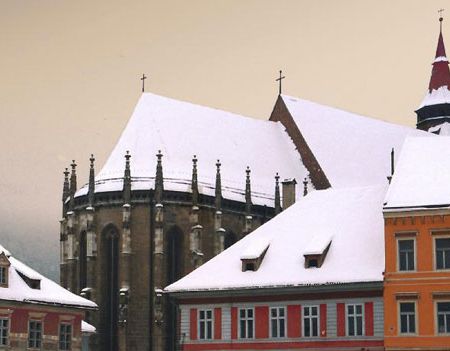
Brasov can be proud with almost 800 years of history. Placed at the foot of the Carpathian Mountains, at the intersection of old commercial roads, connecting with the Danubian Carpathian Basin, resulted in the course of history, Brasov resulted in the course of history as an important industrial, commercial and cultural center.
Among the historic monuments of Romania and especially of Brasov, Black Church occupies a special place. From the architectural point of view it dominates the medieval center of Brasov. The name of the Black Church was given to Parish Church Evangelical Lutheran from Brasov, after the great fire of the city since 1689. Smoke and flames were brown walls, but could not destroy the Black Church.
Construction has been started in a gothic style by the first-priest Thomas Sander in 1383, on the place of a Church from the first half of the century XIII. Almost finished, the Church has suffered serious damage during the first Turkish invasion in 1421. Until 1477 the construciton has been finished and the church was blessed, her patron being the Holly Virgin.
Black Church is the largest religious edifice in the gothic style of south-eastern Europe, measuring 89 meters long and 38 meters wide. This Church can include around 5,000 people.
From the two tours previded in the initial plan in the western part of the church, only the one on the south-west has been realised, amounting to a height of 65 m. In 1689, during the great fire, the church suffered major damage. Restoration took them, like construction, nearly a hundred years. During this period, the impozant roof, with its height of 20 m, receives the current feature, covering now and gallery trafouri initially found there. Rebuilding the interior space, it's gothic style was lost.
The original Gothic vaults have been replaced with a cylindrical vault Baroque (color turquoise).
Black Church is famous not only by its size but also by other things: the bell, which is the largest in the Romanian space, a bronze bell, hard as 6 kg; organ, with more than 4,000 tubes and being one of the largest in South-Eastern Europe. Choir supported by external counterweight establishments, decorated with statues of saints, is one of the few examples of this type in Transylvania. The collection of oriental carpets of the Black Church is the richest of its kind in Romania.
In the Black Church are still preserved three icons of the holy shrine of Feldioara (end of the century XV), one of the most valuable polyptic shrine in the style of late Gothic in Transylvania. The current neo-Gothic style shrine of the Black Church was built in 1866.
On the front wall of the vessel north side is a painting in oil on canvas of the painter Hans Eder (Brasov, 1883-1955), representing the wedding of Cana (1932). On the pillar of the front balcony is located the emblem of Brasov - the crown on the trunk of a tree with roots - above the emblem of King Mathias Corvin. some chairs from the church dates from the year 1696, others in the first half of the XVIIIcentury, presenting a beautiful baroque decorations. The paintings on wood from the seats of former guild presents interesting folklorists issues. The neo-gothic chairs fron the Choir dated from 1866, and the banks of oak with mobile back have been mounted in 1937.

































